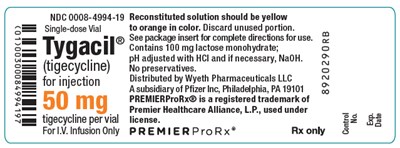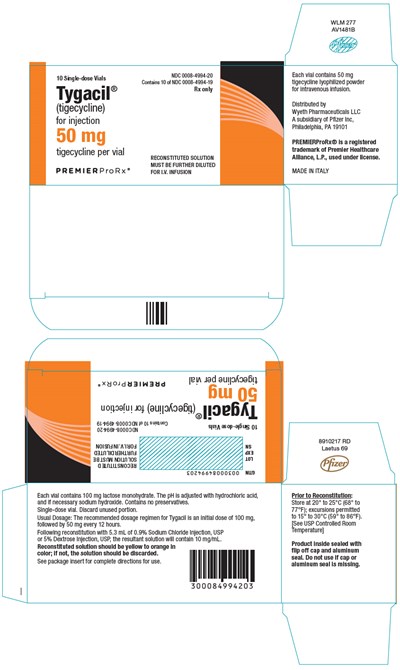Product Images Tygacil
View Photos of Packaging, Labels & Appearance
Product Label Images
The following 4 images provide visual information about the product associated with Tygacil NDC 0008-4994 by Wyeth Pharmaceuticals Llc, A Subsidiary Of Pfizer Inc., such as packaging, labeling, and the appearance of the drug itself. This resource could be helpful for medical professionals, pharmacists, and patients seeking to verify medication information and ensure they have the correct product.
PRINCIPAL DISPLAY PANEL - 50 mg Vial Label - tygacil 03

This is a description of the drug with NDC 0008-4994-19. It indicates that the reconstituted solution should change color from yellow to orange, and any unused portion should be discarded. The package insert contains instructions for use, and the drug contains 100 mg lactose monohydrate, is pH adjusted with HCI and NaOH (if necessary), and does not contain any preservatives. The drug is distributed by Wyeth Pharmaceuticals LLC, a subsidiary of Pfizer, Inc., and is only for IV infusion. It also mentions the trademark, PREMIERProRx®, which is licensed for tigecycline per vial.*
PRINCIPAL DISPLAY PANEL - 50 mg Vial Carton - tygacil 04

Tygacil (tigecycline) is a lyophilized powder for intravenous infusion. Each vial contains 50mg tigecycline per vial and must be further diluted. The solution should be yellow to orange in color, and it must be discarded if it's not in this range. The recommended dosage is an initial dose of 100mg, followed by 50mg every 12 hours. Prior to reconstitution, store it at a temperature of 20° to 25°C. The product is distributed by Wyeth Pharmaceuticals, a subsidiary of Pfizer Inc. This product is for a single-dose and contains no preservatives. Please find package insert for complete directions for use.*
* The product label images have been analyzed using a combination of traditional computing and machine learning techniques. It should be noted that the descriptions provided may not be entirely accurate as they are experimental in nature. Use the information in this page at your own discretion and risk.
